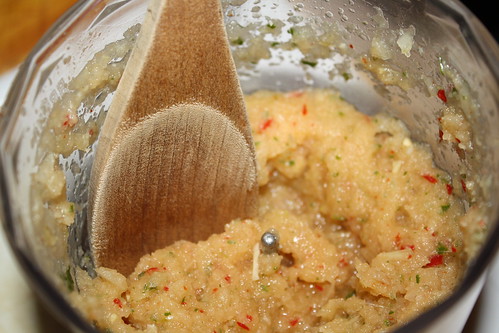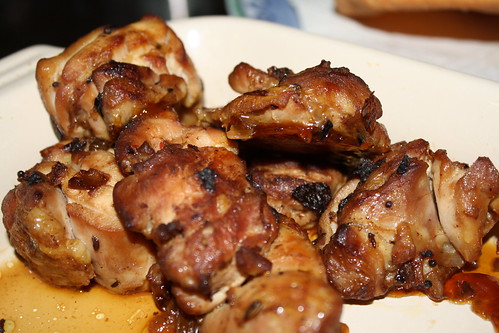While living in England I was lucky (or skilled!) enough to have a recipe published in The Fairtrade Everyday Cookbook. Recipes, using Fairtrade ingredients, were submitted from across the UK and the best were published alongside those of celebrities and chefs. The launch party was also excellent.
However, aside from me showing off my recipe to anyone with the time to look, the book has been underutilised. As part of my new weekly meal planning regime (something which is making life very easy indeed), I’m choosing a random recipe from a random cookbook each week.
Last week it was the Thai fish curry which was submitted by Karen Darnton from Somerset. This recipe is a brilliant example of how easily you can make a tasty Thai style curry without resorting to jars or packets.
Begin by making the curry paste. Into a blender, put two red chillis, the juice and zest of one lime, 2 stalks of lemongrass* (roughly chop these first, and the younger and more tender the better), a generous teaspoon of ginger paste, 4 cloves of garlic, 1 small onion (peeled and roughly chopped), one finely sliced kaffir lime leaf (my addition because I happen to have some in the freezer – leave it out if you don’t have any to hand) and a good splash of Thai fish sauce.
Whizzy this up and you have your paste. This you can make in advance – it will keep quite happily in the fridge in a sealed container for a day or two.
When you’re ready to eat, heat a wok with a small amount of oil (peanut oil or other neutrally flavoured oil) and, when hot, add the curry paste and stir fry for a couple of minutes. You want the pan hot so that it sizzles, and you’ll need to stir to stop it from sticking.
Add a tin of coconut milk, mix well and bring to a simmer.
Next – add your fish. The original recipe used cod, I used barramundi (my barra had the skin on – and normally I would advocate this – but for this recipe, prefer skin off). You want a firm white fish that won’t collapse. You could also use prawns or even chicken thighs (although then it would be a Thai chicken curry …). If using fish, choose Australian and sustainably fished.
Simmer the curry until the fish is cooked.
The original recipe at this point starts adding things like mango or pineapple to the curry but that’s not how I roll, at all. I added a single serve of hokkien noodles to the pot and simmered away until the noodles were separated and hot. So now I had some kind of cross between curry and laksa.
Finally, taste the sauce and add fish sauce or lime juice as required.
Finish with a garnish of coriander and serve immediately.
While this was not the most complex (or, probably, authentic!) Thai curry I’ve ever eaten it certainly ticked all the mid-week meal boxes. Prep in advance, quick to assemble when you’re ready to eat, and tasty to boot. Definitely one we’ll return to.
* As an aside, lemongrass freezes. If you buy a packet from the supermarket, freeze the leftover stems in a snaplock bag. They defrost quickly. Freezing does make them a little tough so be sure to remove the outer layers before using.



